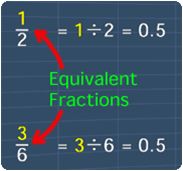Equivalent fractions
Two fractions are equivalent when they express the same part of a unit or when they have the same value.
For example:


We can test if two fractions are equivalent by cross-multiplying their numerators and denominators. This is also called taking the cross-product:
![]()
If you multiply or divide the numerator and the denominator of a fraction by the same number, except zero, you obtain one equivalent fraction.
HOW DO YOU GET EQUIVALENT FRACTIONS? As we said, there are two methods:
- Amplifying: Multiply numerator and denominator by the same number
![]()
- Simplifying: Divide numerator and denominator by the same number.
![]()
Simplifying (or reducing) fractions means to make the fraction as simple as possible. Why say four-eighths (4/8) when you really mean one half (1/2) ?
You make this by dividing the numerator and the denominator by the same number (except zero).
One fraction that you can’t simplify is called irreducible fraction. Then, the numerator and the denominator are coprimes.
To simplify:
- Decompose the numerator and the denominator
- Cross out the numbers that are repeated in the numerator and in the denominator
- If there’s no number in the numerator, put 1
- At the end, you obtain the irreducible fraction equivalent to the first fraction
![]()
Exercises:
1.- Decide if the following pairs of fractions are equivalent or not:
a) 2/5 and 3/7
b) 3/7 and 21/49
2.- Find two equivalent fractions to these ones:
a) -1/5
b) 3/7
3.- Simplify these fractions:
a) 210/300
b) 3000/2700
Solutions: 1.- a) not equivalent; b) equivalent; 2.- a) -2/10 and -3/15; b) 6/14 and 30/70; 3.- a) 7/10; b) 10/9
Obra publicada con Licencia Creative Commons Reconocimiento No comercial Compartir igual 3.0